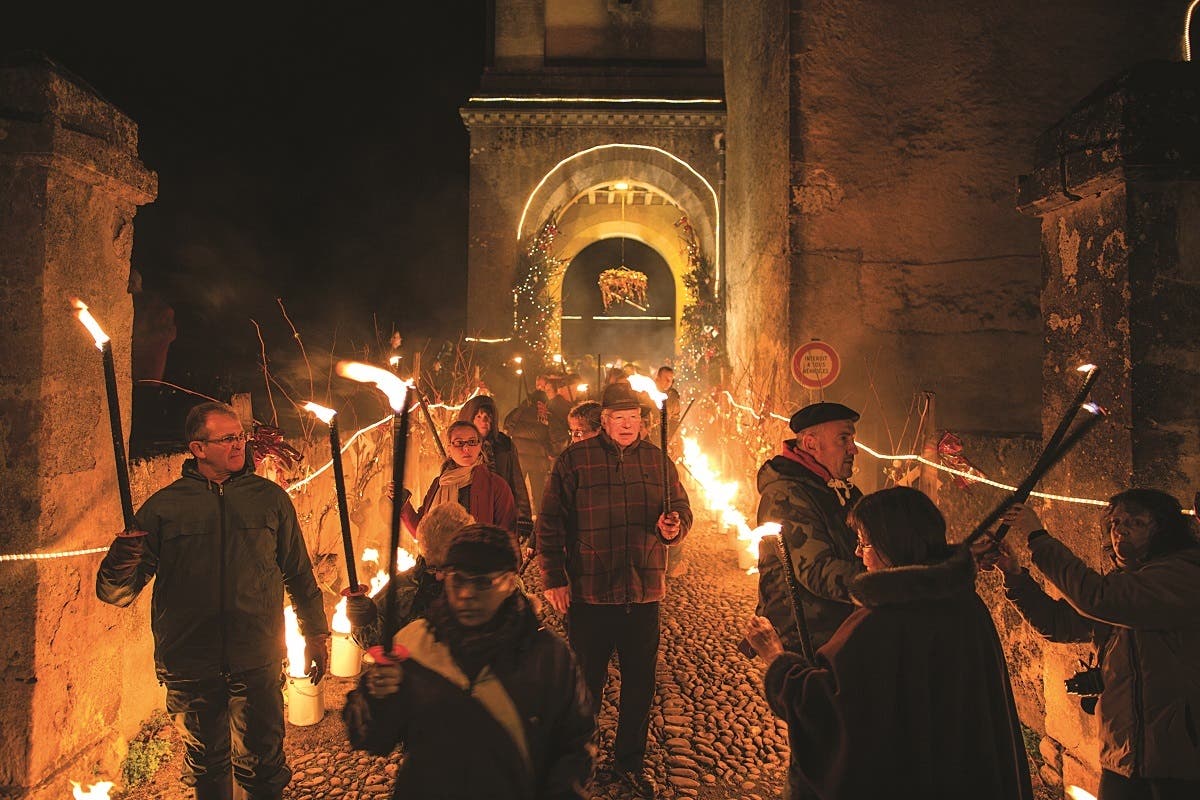
First Night
At a food-filled wine festival in southwest France, a writer raises his glass to the New Year
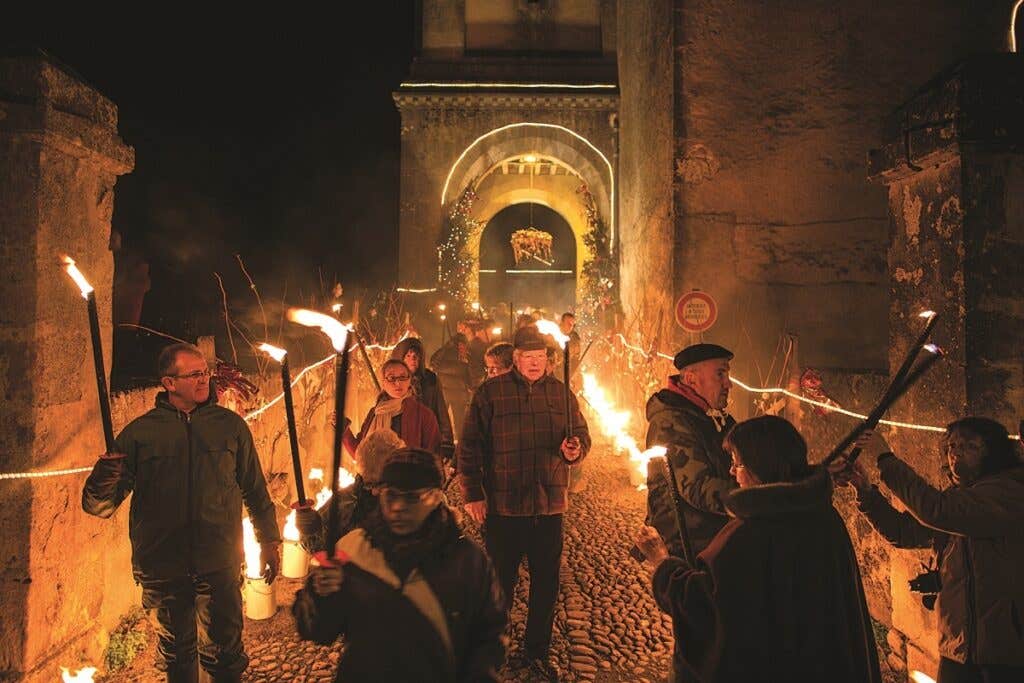
I've never been crazy about New Year's Eve in the United States, with all its boozing and forced jollity. So when I got an invitation last year to celebrate the holiday in a tiny French village in the foothills of the Pyrenees, I jumped at the chance. My hosts were winemakers I'd met on an earlier visit to France's rural southwest, a region for which I have an abiding affection. They'd urged me to come when the village, Viella, holds an annual festival called Les Vendanges du Pacherenc de la St-Sylvestre at the end of December. The name confused me at first. I knew that pacherenc—officially known as pacherenc du vic-bilh, "vine rows of the old village" in a local dialect—was a delicious sweet wine made in very small quantities in a hilly pocket of France between Gascony and the Basque Country. And I knew that St-Sylvestre referred to the Feast of St-Sylvestre, which falls on New Year's Eve. It was the "vendanges" part that baffled. The vendanges, or wine-grape harvests, would surely be over by December 31, even for the latest late-harvest wine.
“But this is a special wine,” Olivier Dabadie, one of the winemakers, had told me. “We protect the grapes to the very end, and the whole village comes out on New Year's Eve to harvest the last rows of vines. Come see for yourself.”
I booked a plane ticket right away and started reading up on Viella, a village of some 500 souls in southwestern France, halfway between Toulouse and the Spanish border. Late-harvest wines have been made in the surrounding hills since at least the mid-18th century, but the New Year's festival started less than a generation ago, after an early freeze delayed the harvest and folks discovered that a December wine was not only possible but wonderful. What the literature didn't convey was just how deep the passion for this obscure wine, and the foods linked with it, ran among the people of Viella.
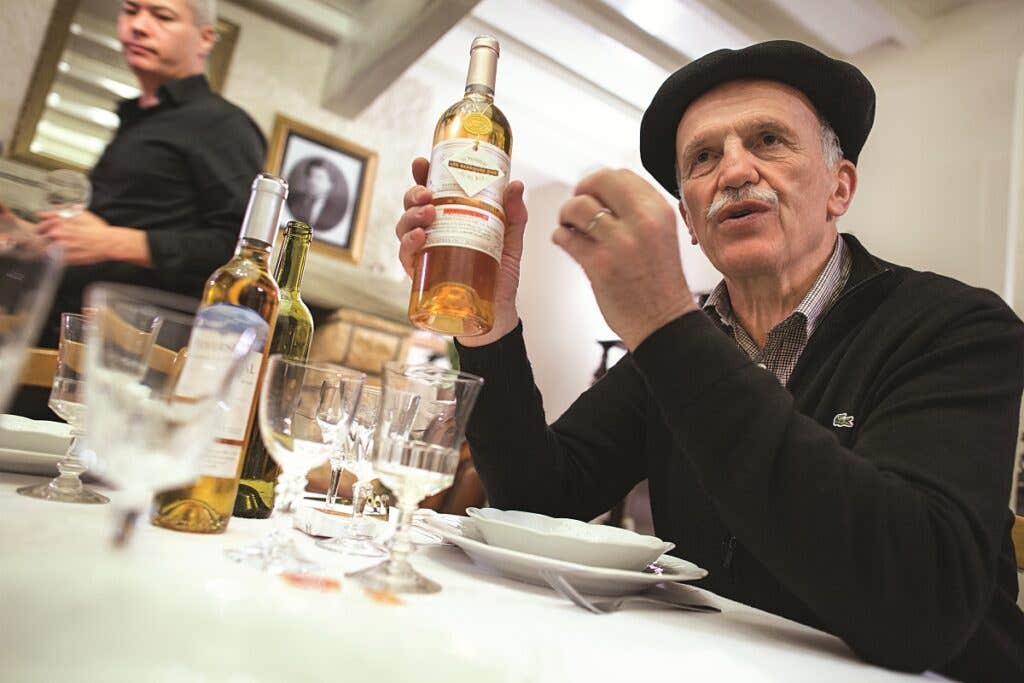
I got to the village on the evening of December 29 after a three-hour drive from Toulouse. There was a main street, a parish church, a café, and a town hall with a statue of a wine bottle perched over the front door, all closed up tight.
I had an invitation that night to have dinner at the home of Nadine Cauzette, president of the Friends of Pacherenc Society, which puts on the festival. At 8 P.M., a slim man with a silver mustache and a black beret picked me up at the inn where I was staying. He introduced himself as André Dubosc and told me that he worked for the local wine cooperative. “Nadine is quite a good cook,” he said as we pulled up to a modest stone house flanked by a barn and a stable.
André had understated the matter. Nadine, a stout widow in her 60s with sparkling eyes, treated us and a few members of her family to an unhurried meal. It embodied every single thing I love about the rich cooking in this corner of France, a rolling landscape of vineyards and small farms that is the nation's cradle of foie gras, duck confit, and cassoulet.
Before we even sat down, there were wonderful pork rillettes and homemade saucisson_accompanied by an apéritif of pacherenc sec, a fresh-tasting dry version of the region's sweet wine. Then came _garbure gersoise, a peasant soup named for Gers, the town's administrative district. The broth was packed with bacon, garlic, and winter root vegetables. Shot through with salty-smoky bass notes, it went perfectly with a bone-dry St-Mont, a wine made in a neighboring range of hills.
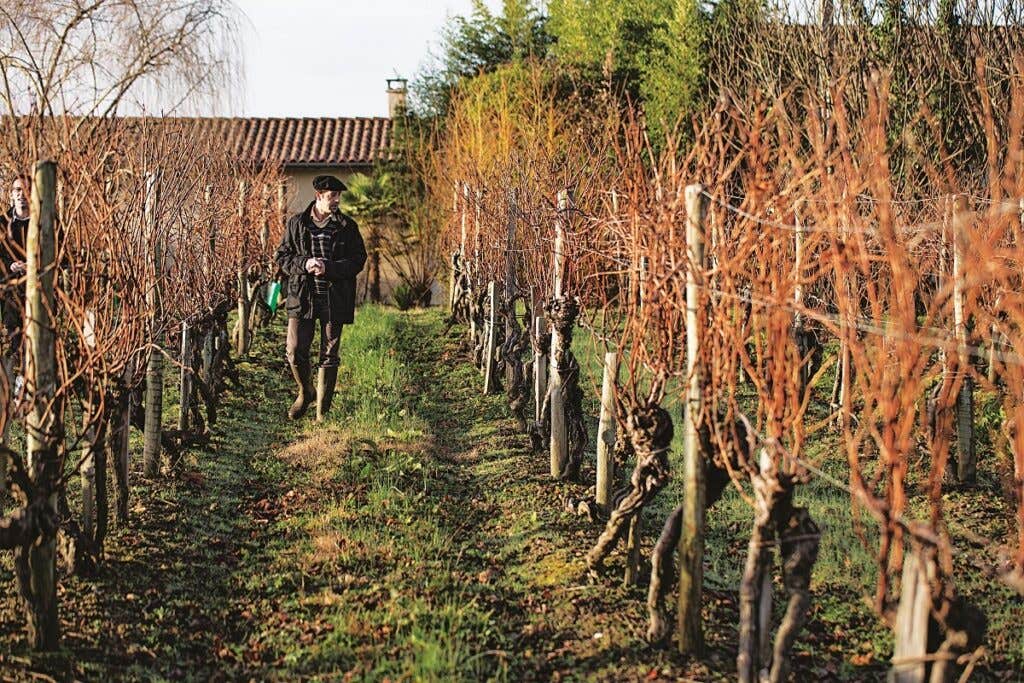
A conversation ensued about the various cultural allegiances of the people of the pacherenc winegrowing region, which André kept calling “notre piémont”—our foot of the mountain. “This is a land of paysans,” he said, “not big châteaux with big investors. It's a land of microregions.”
Indeed, the appellation measures just a dozen miles from end to end, and yet it abuts Gascony, the Basque Country, the mountainous Béam, and the coastal plain of the Landes. A person traveling a very short distance can encounter distinct variations in everything from soup recipes to accents and dialects to the style of farmhouse roofs.
As a final course before dessert, Nadine served a platter of crisp-skinned duck confit. “You must drink madiran with this,” André said, referring to southwest France's famously inky and tannic red wine, which shares pacherenc's viticultural area. He pulled the cork from a 2001 vintage that tasted of cooked plums, earth, and age. Dessert was a pear tart paired with an unctuous, golden pacherenc “hivernal,” made from fruit harvested in mid-December, a sort of runner-up to the vaunted New Year's wine. Though the meal included a lot of different dishes, the wines, made in a style that had evolved with the local cooking, knit everything together, taming rich flavors and brightening subtle ones.
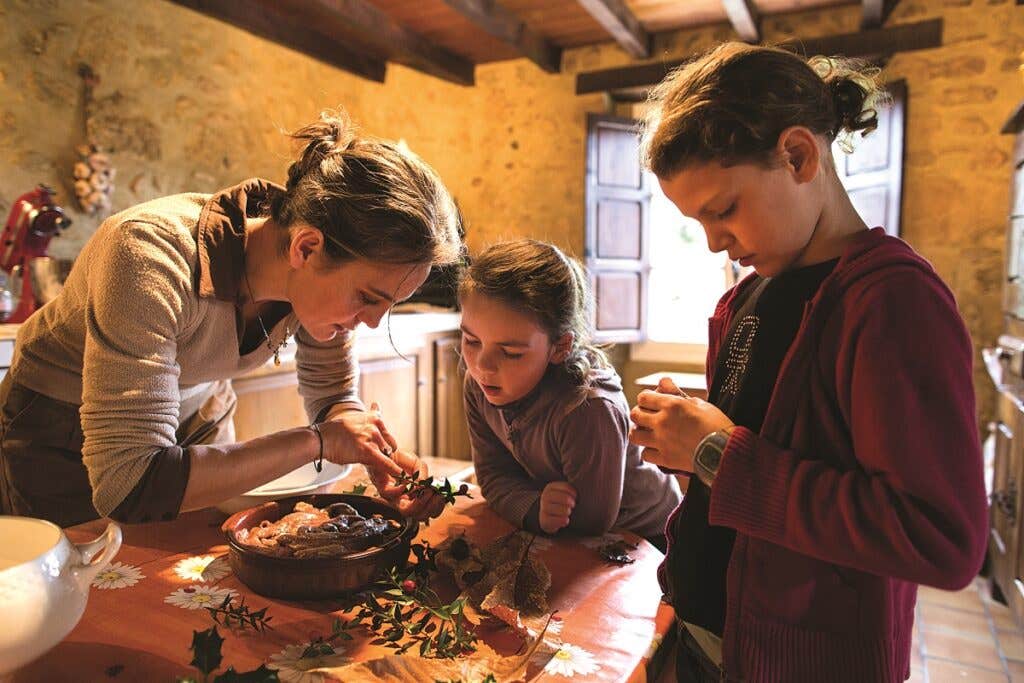
The next morning I took a walk through one of Viella's vineyard parcels with Olivier, who'd first told me about the New Year's festival. I asked him about the St-Sylvestre wine, and he led me over to some rows of leafless vines covered with fine netting. Clusters of plump grapes still dangled from the gnarled branches. “The conditions are perfect on this slope for very late harvesting,” he said, explaining that the sugars in the grapes are concentrated through a ripening process called _passerillage_that relies on natural exposure to wind and sun rather than the introduction of a fungus, which is how the well-known French sweet wine, sauternes, is made.
Olivier's father and brother, Paul, are winemakers too. I had lunch at Paul's house later that day, along with his wife Alice and their three daughters, ages eight, ten, and eleven. Alice served duck breasts flambéed in armagnac, the local brandy that finds its way into so many of the region's dishes, and a cream-thickened chestnut soup called velouté de châtaignes, a wintertime staple in much of rural France. It was velvety and amazingly light on the tongue, perfect for the crisp day. Paul poured the wines: a citrus-tinged 2010 pacherenc sec, then a peppery 2002 madiran, and finally an October-harvest pacherenc that had a nicely restrained sweetness.
For this last wine, Alice brought out a corn-flour tart called a gâteau millasson, which had the consistency of flan and tasted like the best cornbread. The girls polished off their slices quickly and excused themselves to rehearse for the pastorale, the holiday play put on in Viella's church on the night before New Year's Eve. "Paul and I are in the play too!" Alice said. She swore it was not to be missed.
When I arrived that evening, the church was packed, and it seemed like every villager who wasn't squeezed into a pew was a member of the cast. People of all ages, from tots to grandparents, crowded the stage, dressed in curious homemade costumes that ranged from priestly vestments to the garb of a Basque toreador. I could make out Paul Dabadie, attired in what appeared to be a giant papier-mâché wine bottle with robot arms. I couldn't quite follow the gist of the play, which included a lot of singing and dancing, but it kept coming back to pacherenc. Toasts were raised in the wine's honor, benedictions offered in its name, and odes sung to it. One of them ended with a verse in Occitan, an ancient regional dialect; according to the French translation in my program, it went like this: “From road to hillside / Let us sing, sing like summer's cicadas! / Our fair land, the land of Viella / Of pacherenc, of pure wine!”
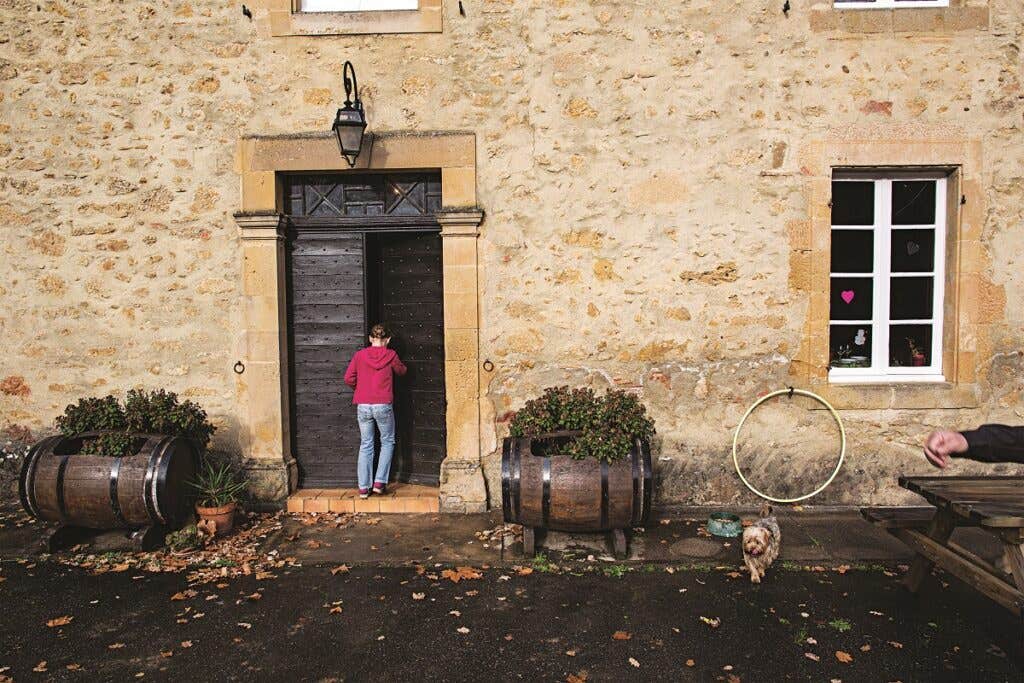
The last day of the year dawned cloudy but by late morning a brilliant winter sun had broken through, and the festival had begun. Viella's town hall was as crowded as the church had been the night before, again almost entirely with locals. In one room, men with weatherworn faces were demonstrating vine-grafting techniques. In another, people debated the merits of various pacherenc producers. In yet another, a winsome baker, Elodie Collavino, was showing a group of women how to make an apple croustade, a traditional tart infused with armagnac and coiffed with a crazy bird's nest of gossamer-thin phyllo dough.
At midday people started heading across the street to the village meeting hall, where long rows of refectory tables had been set for lunch. Assembled on a stage at the far end of the room was a group of older male singers in matching sweaters whom I recognized from the pastorale. As people took their seats, beret-wearing servers whisked chilled bottles of pacherenc to the tables. A jowly man in a ceremonial robe, who I later learned was Paul and Olivier Dabadie's father, gave a speech, thanking the assembled winemakers and their families for their hard work during the prosperous year that was drawing to a close. Then the singers, and everyone else, launched into a song about the nearby Adour River, which once carried wines made in these hills to ships that bore them on to Holland and England.
With seemingly choreographed grace, the first course arrived—a garbure landaise, a more decadent version of the peasant soup Nadine Cauzette had made two nights earlier, packed with duck—followed by beef daube, a Provençal favorite that's also popular in France's southwest, where the meat is braised to fall-apart tenderness in madiran wine.
The food and drink put me in a pleasant reverie that was interrupted from time to time when the crowd stood up to lock arms and sing. Dessert was a croustade. The thin slices of armagnac-doused apples inside had partially melted, and sugar sprinkled onto the tart had caramelized, giving the airy top layers just a little chew.
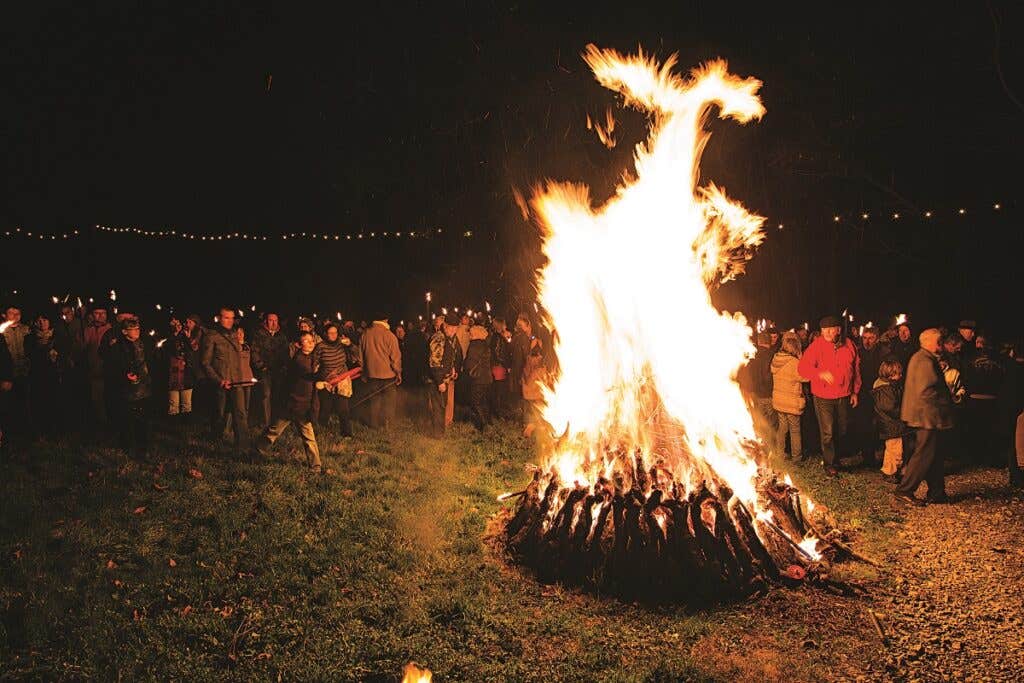
Then Nadine announced that she had a surprise for me: a bottle of New Year's pacherenc from 2009. I was humbled. I wanted to try it then and there, among the people who had helped bring it into being. The straw-colored wine coated the edges of my glass languorously and exploded with aromas of apricot, vanilla, and menthol. I took a sip. A concentrated spicetinged sweetness gave way almost instantly to a silky, clean finish. Nadine touched her glass to mine and said, “À tes amours”—here's to your passions.
That evening, after a much needed nap, I went back to the center of town to witness the culmination of the festival: a torchlit procession from Viella's church to the vineyard where the last rows of grapes awaited harvesting. A huge bonfire had been lit in a nearby clearing. Grown-ups and children walked among the rows of vines, shears in hand, snipping clusters of grapes and tossing them into bins that the men (and a few sturdy women) hoisted onto flatbeds.
Toward the end of the celebration, before everyone split off with family and friends to ring in the New Year, I saw Olivier Dabadie crouching down next to his two young children, Léandre and Lise, coaching them in serious tones on the proper harvesting technique. They looked up at their father and nodded their heads, living proof that their village's unique New Year's tradition would endure.
Keep Reading
Continue to Next Story










